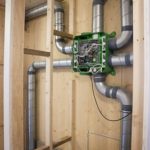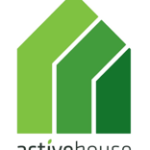Active House Schiedam
 The decision not to include any doors on the ground floor and the introduction of large openings ensures the spaces feel bright and connected to the outdoors. A staircase divides the ground floor into zones for the kitchen and living area.
The decision not to include any doors on the ground floor and the introduction of large openings ensures the spaces feel bright and connected to the outdoors. A staircase divides the ground floor into zones for the kitchen and living area.

In addition to limiting the house’s dependence on artificial lighting, the glazed surfaces also facilitate passive heating. Additional energy required for heating and hot water is produced by a heat pump that operates in conjunction with solar panels.
Most of the bedrooms are east faced to keep them cool.

The air quality on the ground floor is controlled by the natural ventilation system – with CO2 sensor – of Duco.
The house is designed to use as less energy as possible. The energy needed for heating and hot water is produced by a heatpump that makes use of temperature in the ground. Solar panels provide the house with energy for the heat-pump. The panels are cooled and the temperature from that cooling proces is used to heat the source in the ground. By doing so, the installation concept makes use of electric as well as thermal energy from the sun and uses up to 4 times the energy from the sun per panel as a regular solar panel.

The house’s structural shell is from cross-laminated timber (CLT), which reduced the amount of carbon dioxide generated during construction. By designing with CLT we were able to avoid any kind of extra suspensions. There is not a single extra steel beam or structure used, which you usually find in almost any CLT home with wide and open floorspace. By using the walls of the first floor as a suspension, we joined the floors to the walls. The wood of this main structure is treated only with a biobased whitewash. The bricks of the facade are the only “CO2-sin”. We used them to protect the structure from the salty air in this coastal area close to the North Sea. For the floorfinishing Marmoleum was used, which was accurately glued with a product especially developed by a Dutch firm to be able to recycle all the material separately.






